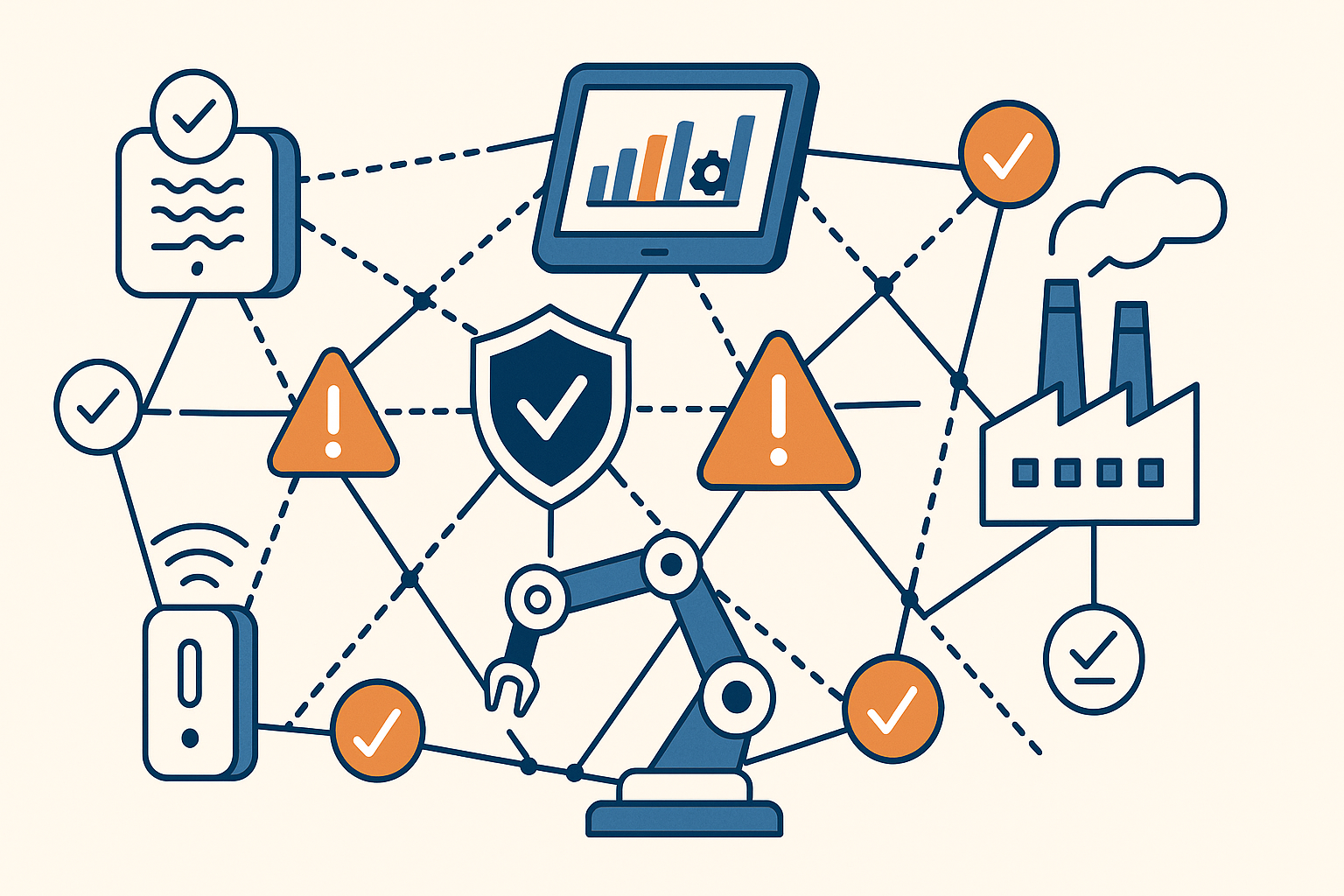
The Internet of Things is everywhere now. Your smartwatch tracks your health. Your thermostat learns your schedule. Your warehouse uses sensors to optimize inventory. But here’s the thing most companies don’t realize until it’s too late: every single one of those connected devices represents a compliance risk that could drain your budget faster than you can say “data breach.”
According to recent research from Transforma Insights, regulatory compliance has overtaken cost and connectivity as the top challenge in IoT. That’s not just corporate speak. It means companies are getting hit with fines, recalls, and lawsuits because they missed critical compliance standards. The European Union’s Cyber Resilience Act can fine you up to €15 million or 2.5% of your worldwide annual revenue. One mistake with IoT security, and you’re looking at penalties that could seriously damage your business.
The problem is that IoT compliance isn’t straightforward. You’re dealing with overlapping regulations like GDPR, HIPAA, the NIST Cybersecurity Framework, and industry-specific rules. Each one has different requirements, different timelines, and different consequences for getting it wrong. Most organizations lack the in-house expertise to manage these modern compliance challenges. A 2025 Government Accountability Office report confirmed what many leaders already suspected: most companies simply aren’t equipped to handle IoT regulatory compliance on their own.
But here’s the good news. Most compliance failures follow predictable patterns. By understanding the five most common mistakes, you can protect your organization from expensive regulatory nightmares before they happen.
Mistake #1: Treating Firmware Updates as Optional
Let’s start with the biggest vulnerability in IoT device security: outdated firmware. According to the IoT Security Foundation, 60% of IoT breaches happen because of outdated firmware. That’s not a typo. More than half of all successful attacks exploit vulnerabilities that manufacturers already patched.
Think about that for a second. Companies are getting breached not because hackers discovered some zero-day exploit, but because organizations didn’t apply updates that were already available. It’s like leaving your front door unlocked and then being surprised when someone walks in.
The problem gets worse when you consider that many IoT devices ship with preloaded vulnerabilities. Manufacturers rush products to market because competition is fierce. Time-to-market pressure leads to security shortcuts. Then devices sit in the field for years without updates, becoming easier targets with each passing day.
Regulatory frameworks now mandate secure update mechanisms throughout a device’s lifecycle. The OWASP Top 10 IoT specifically calls out the lack of secure firmware update mechanisms as a critical vulnerability. The EU’s Radio Equipment Directive, with obligations that became mandatory in August 2025, requires devices to implement ongoing software updates as part of their cybersecurity requirements.
Here’s what you need to do instead:
Implement over-the-air (OTA) updates with proper security controls. Your update mechanism needs cryptographic signing to verify authenticity, encryption during transmission using AES-256 and TLS 1.3, and anti-rollback protection to prevent attackers from downgrading to vulnerable versions. Companies that regularly update IoT firmware cut attack risks in half.
Create a clear update schedule and stick to it. Don’t wait for a breach to force your hand. Monitor for vulnerabilities continuously, apply patches promptly, and maintain detailed documentation of your update history for compliance audits.
Make updates automatic whenever possible. Manual update processes don’t scale when you have hundreds or thousands of devices deployed. Enable silent background updates with proper testing protocols to ensure updates don’t brick devices in the field.
Mistake #2: Ignoring Default Passwords and Authentication Weaknesses
Weak or default passwords are the number one cause of IoT breaches. Let me repeat that because it’s important: the single biggest security vulnerability in IoT is something as basic as password management.
The infamous Mirai botnet, which launched massive DDoS attacks, succeeded by exploiting IoT devices with hardcoded credentials. These weren’t sophisticated attacks. Attackers simply tried common default usernames and passwords like “admin/admin” or “root/root.” It worked because manufacturers shipped devices with these credentials, and users never changed them.
This isn’t just a security problem. It’s a compliance problem. The UK’s Product Security and Telecommunications Infrastructure (PSTI) Act, enacted in 2022, specifically bans default passwords for consumer IoT products. The NIST Cybersecurity Framework requires strong authentication mechanisms. HIPAA mandates robust access controls for any device handling protected health information (PHI).
The challenge is that many connected devices have limited user interfaces. A sensor in a warehouse doesn’t have a screen where someone can type a complex password. This creates a real implementation problem that requires thoughtful solutions.
Here’s the right approach:
Force password changes during initial setup. Don’t let devices operate with factory defaults under any circumstances. Build this requirement into your deployment process so there’s no way to skip it.
Implement certificate-based authentication where possible. Digital certificates provide stronger security than passwords and work well for machine-to-machine communication. This approach aligns with modern IoT security best practices and simplifies credential management at scale.
Use multi-factor authentication for any device or system that supports it. Adding an extra authentication layer dramatically reduces the risk of unauthorized access, even if credentials are compromised.
Regularly audit your device authentication across your entire IoT deployment. Look for weak credentials, shared passwords across multiple devices, or expired certificates. Make this part of your routine compliance monitoring process.
Mistake #3: Skipping Network Segmentation
Letting IoT devices freely connect to your main business network is a massive mistake that could expose your entire infrastructure to attack. According to Verizon’s 2024 Data Breach Investigations Report, one in three breaches now involves an IoT device. These devices often become the entry point that attackers use to reach more valuable systems.
Think of your network like a building with different departments. You wouldn’t give the cleaning crew keys to the executive offices and the server room. Similarly, a smart thermostat shouldn’t have access to your customer database or financial systems.
The problem is that many organizations treat network design as an afterthought. They focus on getting devices connected and operational without considering the security implications. A single compromised device then provides attackers with a foothold they can use to move laterally through your network.
Network segmentation creates boundaries that contain potential breaches. Research shows that businesses using proper segmentation reduce breach costs by 35%. That’s a significant risk reduction from implementing what should be a standard security practice.
Regulatory compliance increasingly expects network isolation for IoT. The NIST guidelines recommend network segmentation as a core security control. The EU’s NIS2 Directive requires organizations to implement supply chain security measures, which includes isolating potentially vulnerable devices.
Here’s how to implement effective segmentation:
Create dedicated VLANs or network segments for IoT devices. Keep them completely separate from your corporate network, customer data systems, and critical infrastructure. Use firewalls to control traffic between segments and limit communication to only what’s necessary.
Implement zero-trust principles where possible. Don’t assume that devices on your IoT network are trustworthy just because they’re “inside” your perimeter. Verify every connection attempt and limit access based on the principle of least privilege.
Monitor traffic between network segments continuously. Use IoT-aware network detection and response (NDR) tools that can parse industrial and proprietary protocols. Look for anomalous behavior like unusual data transfers, unexpected connections, or devices communicating when they shouldn’t be.
Document your network architecture thoroughly. Compliance audits will want to see how you’ve isolated IoT devices and what controls you have in place. Clear documentation also helps your team maintain proper segmentation as your environment evolves.
Mistake #4: Neglecting Data Encryption and Privacy Requirements
Unencrypted data transmission is unacceptable for any serious IoT implementation, yet it remains surprisingly common. Many IoT devices transfer data over the internet without proper encryption, leaving sensitive information exposed to anyone who can intercept the traffic.
The regulatory landscape around data privacy has become increasingly strict. GDPR mandates encryption for personal data both in transit and at rest. HIPAA requires technical safeguards to protect electronically transmitted protected health information. The California Consumer Privacy Act (CCPA) gives consumers rights over their personal information, with serious penalties for companies that fail to protect it.
Healthcare organizations face particularly complex challenges. IoT devices in medical settings collect vital signs, patient IDs, and treatment data. This information must comply with multiple overlapping regulations. Poor handling of this data can result in breaches that compromise patient privacy, trigger mandatory breach notifications, and expose organizations to lawsuits and regulatory fines.
Data residency adds another layer of complexity. Many cloud-based IoT systems store or process data internationally. This creates potential conflicts with data sovereignty laws. Cross-border data transfers might violate GDPR requirements or local regulations in countries where your devices operate.
Here’s what compliant encryption looks like:
Encrypt data in transit using TLS 1.2 or higher for all communications. Use AES-256 for payload encryption and secure hashing algorithms like SHA-2. Replace any legacy protocols like HTTP or FTP with secure alternatives. Every data transmission should be protected, not just the ones you think might contain sensitive information.
Encrypt stored data wherever it might contain personal data or other sensitive information. This includes data on the device itself, in your backend systems, and in any cloud storage. Consider data lifecycle requirements and ensure you can securely delete information when regulations require it, like GDPR’s “right to be forgotten.”
Manage cryptographic keys carefully. Encryption is only as strong as your key management practices. Use hardware security modules (HSMs) or secure key management services to protect encryption keys. Rotate keys regularly and have documented procedures for key lifecycle management.
Implement proper access controls and logging. Track who accesses what data and when. This creates the audit trails that regulators expect and helps you detect unauthorized access quickly. Many compliance standards specifically require detailed logging capabilities.
Mistake #5: Failing to Plan for Lifecycle Compliance
Most organizations focus on getting their IoT deployment up and running. They handle the initial certifications and regulatory approvals. Then they assume they’re done with compliance. This is a dangerous misconception that leads to serious problems down the road.
Modern regulations include post-market obligations that last throughout a device’s entire lifecycle. You can’t just launch a product and walk away. The EU’s Cyber Resilience Act requires ongoing vulnerability management. The NIST Cybersecurity Framework emphasizes continuous risk assessment. HIPAA mandates regular security evaluations.
The GAO report on IoT wireless device compliance monitoring highlighted a critical gap: federal agencies aren’t adequately tracking post-deployment compliance. This monitoring gap means organizations can’t rely on external oversight to catch problems. You need robust internal processes.
Documentation becomes crucial over time. You need to maintain records of security measures, update history, incident responses, and compliance activities. Three years after deployment, when a vulnerability is discovered, you’ll need to prove you followed proper security practices. Without documentation, you can’t demonstrate compliance even if you did everything right.
Supply chain complexity makes lifecycle management even harder. A single IoT device might incorporate components from dozens of suppliers. Regulations increasingly require Software Bills of Materials (SBOMs) that inventory every software component. Gartner predicted that 60% of organizations responsible for critical infrastructure software would mandate SBOMs by 2025.
Here’s how to manage compliance throughout the device lifecycle:
Develop a comprehensive lifecycle management plan before deployment. Define update schedules, security assessment frequencies, documentation requirements, and end-of-life procedures. Make sure you have resources allocated for ongoing compliance activities, not just initial launch.
Create and maintain detailed documentation for every compliance-related activity. Document security architecture decisions, risk assessments, update deployments, security incidents, and remediation actions. Use centralized systems to manage this documentation so it’s readily available for audits.
Conduct regular compliance assessments using established frameworks. The NIST Cybersecurity Framework 2.0 provides an excellent structure for ongoing evaluation. Schedule periodic reviews of your IoT security posture, ideally quarterly or at minimum annually.
Plan for secure end-of-life from the beginning. Devices won’t last forever. You need documented procedures for safely decommissioning devices, securely wiping data, and ensuring compliance even as devices are removed from service. Recent NIST guidance specifically addresses secure end-of-life strategies.
Stay informed about evolving regulatory requirements. The compliance landscape changes constantly. Assign someone to monitor regulatory developments in your industry and regions where you operate. What’s compliant today might not meet requirements next year.
Taking Control of IoT Compliance
IoT compliance doesn’t have to be overwhelming if you address these five critical mistakes systematically. Update your firmware regularly with secure OTA mechanisms, eliminate default passwords and implement strong authentication, segment your networks to contain potential breaches, encrypt all sensitive data in transit and at rest, and plan for lifecycle compliance from day one.
Companies that proactively address these areas significantly reduce their risk of costly regulatory violations, security breaches, and operational disruptions. The cost of implementing proper IoT security and compliance measures is far less than the fines, recalls, and reputation damage that follow when things go wrong. Take action now, before regulatory enforcement or a security incident forces your hand. For detailed technical guidance on implementing these best practices, the NIST Cybersecurity for IoT Program provides comprehensive frameworks, and the European Union Agency for Cybersecurity offers region-specific compliance resources for organizations operating in European markets.











